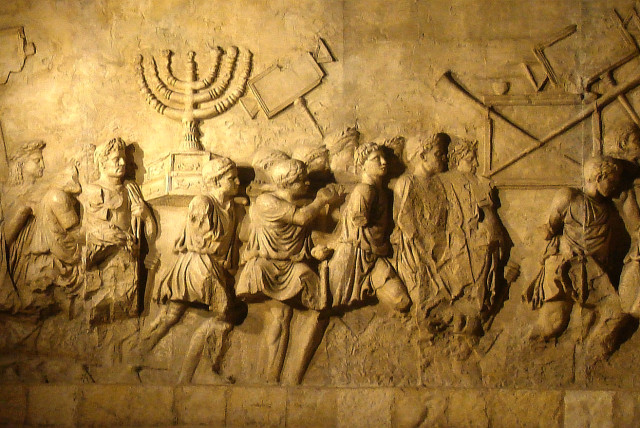Forgotten Jewish revolts show poor historical literacy in Jewish world - opinion

Archaeological find of 4th-century coins in Lod challenges historical narratives about Jewish revolts against Roman and Byzantine rule, revealing lesser-known episodes of Jewish history.
The archaeological world was set abuzz recently by the discovery in Lod of a 4th-century hoard of coins from the time of the Jewish revolt against Roman emperor Gallus. Stories about the discovery appeared on many local and foreign sites. Haaretz, The Times of Israel and The Jerusalem Post reported that the Gallus Revolt was the last revolt by the Jews of the Holy Land against Roman rule. They were wrong.
There was one more revolt, this one against emperor Heraclius in the 7th century. In his book, Jerusalem (2011) Simon Sebag Montefiore describes the details of the Heraclius Revolt which, I suspect, many readers may never have heard of. I had not until I stumbled on it a few years ago.
The earlier Gallus Revolt against Constantine Gallus, ruler of the Eastern Roman Empire (Byzantium), took place from 351-352. The focal points were in Galilee at Tzippori and Tiberius, but the discovery of the coins in Lod (a 2007 article by G Bijovsky in the Israel Exploration Journal notes that coins from the Gallus Revolt were found at Lod) indicates that the revolt likely extended further south as well. A senior Roman commander, Ursicinus, suppressed the revolt, killing thousands of rebels.
The final Jewish effort to gain autonomy in Palestine before modern times, the revolt against Heraclius, emperor of the Eastern Roman Empire, broke out in 614 CE amid a broader conflict between Heraclius and the Sasanians (Persians). Twenty thousand to 26,000 Jewish men fought in the campaign, recruited from a Jewish population estimated to range from 150,000-400,000. There were heavy losses on both sides. Initial successes, including a Jewish takeover of Jerusalem, came to naught in 617 CE when the Sasanians reneged on their support for the Jews.
Poor historical literacy in the Jewish world
These later revolts, known primarily from non-Jewish sources, are not widely acknowledged. They highlight the poor level of historical literacy that exists in the Jewish world. If I had a dollar (well, maybe $10) for each time that I read an article that described the destruction of the Temple in Jerusalem in 70 CE as marking the end of Jewish independence and the beginning of 2,000 years of Jewish wandering over the face of the earth, I would be a wealthy man. And yet, that account is not true.
THE DESTRUCTION of the Temple did not mark the end of Jewish independence because Judea had lost its independence earlier when it became part of the Roman Empire in 63 BCE. In fact, the 2,000 years between the onset of the Roman Empire and the beginning of the 20th century can be characterized, for the Mediterranean world, as dominated by empires, whether the Roman Empire, the Caliphates, or the Ottoman Empire. No national group was truly independent. Even far-off Britain was a part of the Roman Empire for over 350 years.
Nor did the Jewish people disappear from the Holy Land for 2,000 years. A significant number of Jews, a majority of the population of the Land of Israel, remained and prospered for at least 600 years after the fall of Masada. The remains of 80 synagogues built during this period are evident. (Prominent examples include Bar’am, Korazim, and Beit Alpha.) The Sanhedrin continued to function until the 4th century and a Jewish patriarchate existed until the 5th century.
Evidence from the Cairo Geniza and the writings of the Spanish-Jewish traveler Benjamin of Tudela indicate that Jews continued to inhabit a number of towns, including Jerusalem, after the Byzantine defeat by the Arabs in 637 CE, and even during the Crusader rule. In fact, because of easier travel options, the 13th century witnessed an upsurge in Jewish immigration from Europe, including a number of Tosafists (prominent rabbis from France, Germany, Bohemia, and Austria, who lived from the 12th-mid-15th centuries); noted Spanish rabbi and philosopher Nachmanides (the Ramban) arrived in Israel in 1267.
The Jewish population increased or decreased as a function of immigration (when allowed), natural disasters, and disease. The expulsions from Spain (1492) and Portugal (1497) led to the establishment of a sizable 16th-century Jewish community in Safed, one that became a major Judaic center as well as an important focus for the wool trade and the textile industry.
In the late 1700s and early 1800s, well before the onset of the First Aliyah in 1881, numbers of hassidic Jews, as well as their rivals, the followers of the Vilna Gaon, made aliyah. By the mid-1800s, Jews constituted more than half the population of Jerusalem.
Sadly, this rich history of Jewish life in the Holy Land is largely unknown to many Jews and non-Jews alike. How can we Jews know who we are and where we came from if we do not know our own history? Sometimes I feel like one of the figures in a cartoon I recently noticed on the Internet, who says: “Those who don’t study history are doomed to repeat it. Yet those who do study history are doomed to stand by helplessly while everyone else repeats it.”
The writer, a fellow of the Royal Society of Canada, is a retired professor, University of Waterloo.
Jerusalem Post Store
`; document.getElementById("linkPremium").innerHTML = cont; var divWithLink = document.getElementById("premium-link"); if (divWithLink !== null && divWithLink !== 'undefined') { divWithLink.style.border = "solid 1px #cb0f3e"; divWithLink.style.textAlign = "center"; divWithLink.style.marginBottom = "15px"; divWithLink.style.marginTop = "15px"; divWithLink.style.width = "100%"; divWithLink.style.backgroundColor = "#122952"; divWithLink.style.color = "#ffffff"; divWithLink.style.lineHeight = "1.5"; } } (function (v, i) { });

